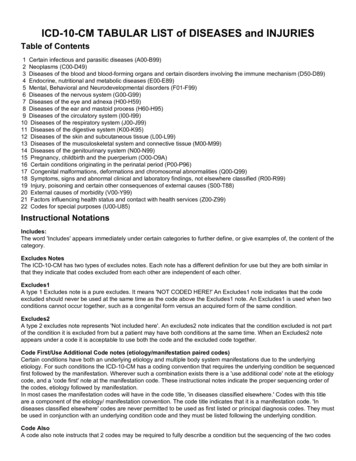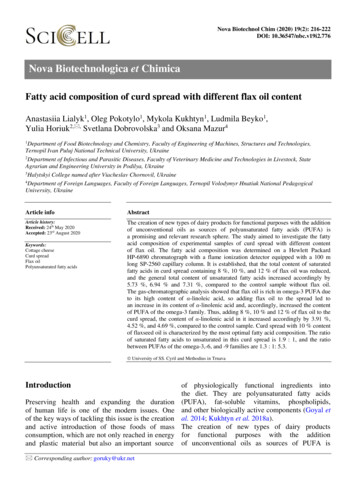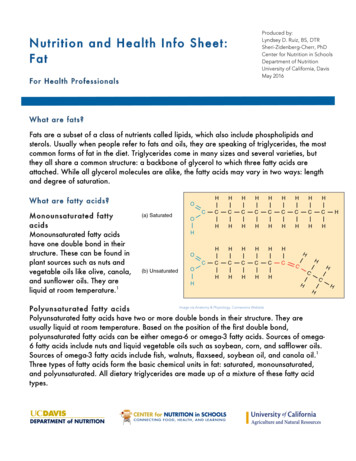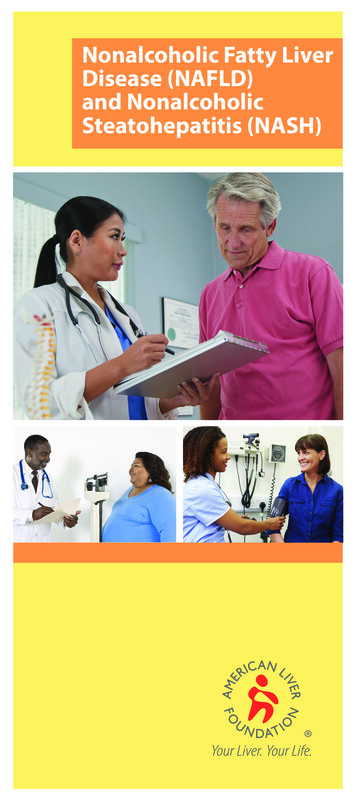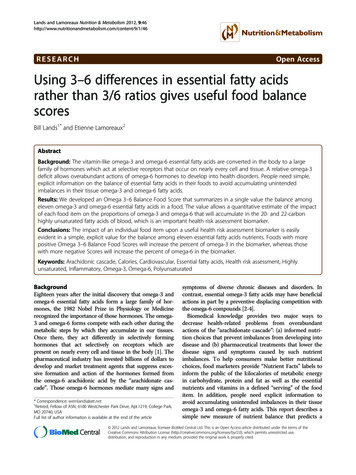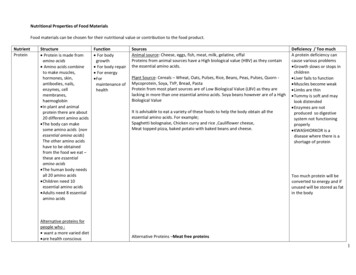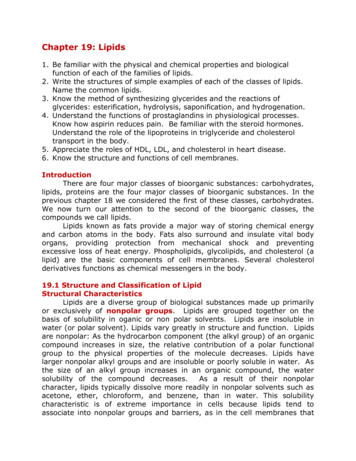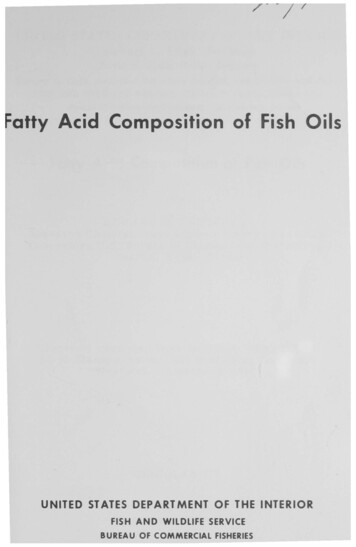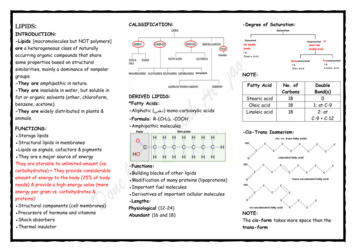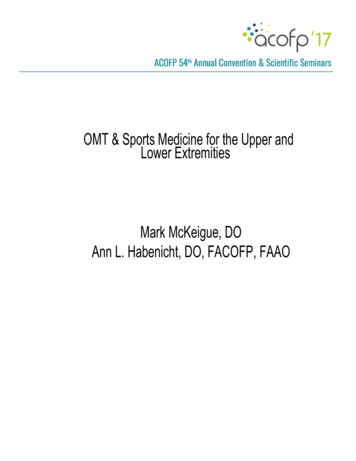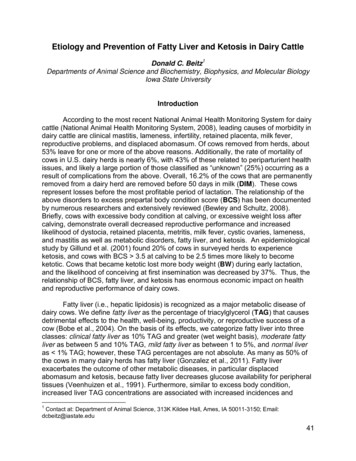
Transcription
Etiology and Prevention of Fatty Liver and Ketosis in Dairy CattleDonald C. Beitz1Departments of Animal Science and Biochemistry, Biophysics, and Molecular BiologyIowa State UniversityIntroductionAccording to the most recent National Animal Health Monitoring System for dairycattle (National Animal Health Monitoring System, 2008), leading causes of morbidity indairy cattle are clinical mastitis, lameness, infertility, retained placenta, milk fever,reproductive problems, and displaced abomasum. Of cows removed from herds, about53% leave for one or more of the above reasons. Additionally, the rate of mortality ofcows in U.S. dairy herds is nearly 6%, with 43% of these related to periparturient healthissues, and likely a large portion of those classified as “unknown” (25%) occurring as aresult of complications from the above. Overall, 16.2% of the cows that are permanentlyremoved from a dairy herd are removed before 50 days in milk (DIM). These cowsrepresent losses before the most profitable period of lactation. The relationship of theabove disorders to excess prepartal body condition score (BCS) has been documentedby numerous researchers and extensively reviewed (Bewley and Schultz, 2008).Briefly, cows with excessive body condition at calving, or excessive weight loss aftercalving, demonstrate overall decreased reproductive performance and increasedlikelihood of dystocia, retained placenta, metritis, milk fever, cystic ovaries, lameness,and mastitis as well as metabolic disorders, fatty liver, and ketosis. An epidemiologicalstudy by Gillund et al. (2001) found 20% of cows in surveyed herds to experienceketosis, and cows with BCS 3.5 at calving to be 2.5 times more likely to becomeketotic. Cows that became ketotic lost more body weight (BW) during early lactation,and the likelihood of conceiving at first insemination was decreased by 37%. Thus, therelationship of BCS, fatty liver, and ketosis has enormous economic impact on healthand reproductive performance of dairy cows.Fatty liver (i.e., hepatic lipidosis) is recognized as a major metabolic disease ofdairy cows. We define fatty liver as the percentage of triacylglycerol (TAG) that causesdetrimental effects to the health, well-being, productivity, or reproductive success of acow (Bobe et al., 2004). On the basis of its effects, we categorize fatty liver into threeclasses: clinical fatty liver as 10% TAG and greater (wet weight basis), moderate fattyliver as between 5 and 10% TAG, mild fatty liver as between 1 to 5%, and normal liveras 1% TAG; however, these TAG percentages are not absolute. As many as 50% ofthe cows in many dairy herds has fatty liver (Gonzalez et al., 2011). Fatty liverexacerbates the outcome of other metabolic diseases, in particular displacedabomasum and ketosis, because fatty liver decreases glucose availability for peripheraltissues (Veenhuizen et al., 1991). Furthermore, similar to excess body condition,increased liver TAG concentrations are associated with increased incidences and1Contact at: Department of Animal Science, 313K Kildee Hall, Ames, IA 50011-3150; Email:dcbeitz@iastate.edu41
severity of laminitis, mastitis, milk fever, retained placenta, and metritis (Herdt, 1991). Inthe long-term, increased TAG concentrations are associated with decreasedreproductive success and milk production in dairy cows. Given these facts, it is clearthat a preventive for fatty liver would improve health, well-being, productivity,reproduction, and average lifetime of cows, which would result in major savings for U.S.dairy farmers.Hypothesis for Our ResearchOn the basis of previous findings, we hypothesized that glucagon will preventaccumulation of TAG in liver of early lactation dairy cows by increasing glucose and lipidavailability for peripheral tissues and by decreasing lipolysis in adipose tissue, therebycounteracting the effects of proinflammatory cytokines, in particular tumor necrosisfactor (TNF ). This hypothesis is based on results that demonstrate that fatty liver ispreceded by and highly correlated with (r 0.96) increased prepartal plasma TNF concentrations and that fatty liver can be prevented by glucagon injection (Nafikov et al.,2006).Research Goal and SummaryVeterinarians and herd managers have expressed a strong need for “tools” toprevent fatty liver and the array of prepartal diseases and disorders. Our long-term goalis to develop an effective and practical on-farm preventive for fatty liver that willdecrease the incidence and severity of fatty liver and other periparturient diseases,thereby improving health, well-being, productivity, reproduction, and average lifetime ofdairy cows. We expect future research to lead to such a tool. Our previous researchhas helped define the etiology and metabolic physiological consequences of ketosis andfatty liver (Hippen et al., 1999; Nafikov et al., 2006) and has led to an improvednutritional protocol that causes fatty liver for experimentation and to the development ofglucagon as a treatment/preventive of clinical fatty liver. Glucagon has no knownharmful effects on cattle, and it is a relatively small peptide that can be produced byrecombinant or chemical means, which makes it economically feasible as a slowrelease subcutaneous implant for use in the dairy industry.In summary, our research has shown that subcutaneous injections of glucagonprepartally prevents fatty liver by increasing glucose and lipid availability for peripheraltissues through increasing hepatic gluconeogenesis and lipoprotein secretion anddecreasing adipocyte lipolysis, thereby counteracting the detrimental effects ofinflammatory factors such as TNFα. Application of our results is expected to decreasethe incidence of fatty liver and related periparturient diseases and to increase thehealth, productivity, reproduction, lifetime, and well-being of dairy cows, which willimprove the profitability of dairying in the U.S. Practical implementation of the validatedapproach will require from us further development of (1) noninvasive techniques, suchas ultrasonography (Bobe et al., 2008; Weijers et al., 2012), for diagnosis of fatty liverand (2) a slow-release formulation for the delivery of glucagon (similar to commercialbovine somatotropin) for on-farm application.42
Pathology of Fatty LiverThe pathology of bovine fatty liver (i.e., hepatic lipidosis) is well known. Up to 50%of all dairy cows accumulate excessive TAG in cells of liver and other organs (i.e., kidneyand skeletal and cardiac muscles) during the peripartal and early postpartal period(Gerloff et al., 1986). If fatty liver is left untreated, cows often display signs of hepaticencephalopathy; symptoms progress from loss of appetite to general depression, toataxia, to recumbency, to coma, and finally to death of the cow because of failure ofaffected organs. In fatty liver, accumulation of TAG in parenchymal cytoplasm isaccompanied by disturbances in hepatic structure, including fatty cysts in liverparenchyma, increased cell volume, compression of sinusoids, decreased volume ofrough endoplasmic reticulum, and mitochondrial damage, and by disturbances inmetabolism, including decreased gluconeogenesis, because of decreasedphosphoenolpyruvate carboxykinase (PEPCK) synthesis and activity, ketogenesis,ureagenesis, and lipoprotein synthesis and secretion, and increased lipid peroxidation(Bobe et al., 2004). In cows with hepatic steatosis, damages in hepatic structureprogress into liver necrosis and cirrhosis, and metabolic disturbances progress into‘steep’ decreases in hepatic gluconeogenesis, oxidative processes, and ureagenesis,causing toxic concentrations of ammonia (Veenhuizen et al., 1991).Fatty liver is associated with the duration and severity of other diseases (Gerloff etal., 1986) and decreased milk production and reproductive success. The damagingeffects of excessive accumulation of TAG on the structure and metabolism of affectedorgans together with the increased concentrations of ammonia, ketone bodies, andnonesterified fatty acids (NEFA) in plasma and the decreased peripheral glucose, lipid,and amino acid availability explain why hepatic TAG concentrations determine theoutcome of a myriad of additional disorders (Rehage et al., 1986). For example, cowswith clinical fatty liver retained viable bacteria in the mammary gland much longer afterexperimental mastitis than did cows with slight fatty infiltration of liver (Hill et al., 1985).Cows with fatty livers are leukopenic, with decreases in neutrophils, eosinophils, andlymphocytes (Herdt et al., 1986). In both the peripartal and early postpartal period, fattyliver is associated strongly with ketosis left displaced abomasum, decreased immuneresponse, increased susceptibility for retained placentas and parturient paresis, infectiousdiseases such as lameness, mastitis, and metritis , and fertility problems (Bobe et al.,2004). Cows that are obese at calving almost invariably have fatty liver and are highlysusceptible to a complex of metabolic and infectious diseases known as "fat-cowsyndrome". In one high-incidence herd, morbidity was 82% and mortality was 25%(Morrow et al., 1979). Postpartal serum NEFA concentrations are associated with the riskof developing displaced abomasum, clinical ketosis, metritis, and retained placenta duringthe first 30 days of lactation (Ospina et al., 2010).Etiology of Fatty LiverDeposition of TAG in liver is the consequence of mobilization of NEFA fromadipose tissue exceeding capabilities of liver for oxidation and secretion of lipids (Gross etal., 2013). Cows with fatty liver have greater adipose stores and mobilize more TAG,43
which leads to greater plasma NEFA concentrations, because adipose tissue from cowswith fatty liver is less responsive to lipogenic substances and more responsive to lipolyticsubstances. Furthermore, cows with fatty liver have decreased fatty acid oxidation,hepatic apolipoprotein synthesis and lipid secretion, as indicated by decreased plasmaapolipoprotein and lipid concentrations and decreased serum lecithin: cholesterolacyltransferase (LCAT) activity (Bobe et al., 2004). Besides disturbances in lipidmetabolism, cows with fatty liver also have disturbances in glucose metabolism: Cowswith fatty liver are either hyperinsulinemic-hyperglycemic or hypoinsulinemichypoglycemic (Holtenius, 1991), because either peripheral glucose uptake is decreased,indicating insulin resistance, or insulin and glucagon secretion and, therefore, hepaticgluconeogenesis are decreased. Furthermore, plasma amino acids are decreased. Insummary, the availability of glucose, amino acids, and lipids for peripheral tissues isdecreased in cows with fatty liver.The metabolic effects in the etiology of fatty liver may in part be explained by director indirect actions of TNFα, a proinflammatory cytokine synthesized by macrophages,lymphocytes, and primarily adipose tissue (Bradford et al., 2009; Trevisi et al., 2012).Infections, trauma, and also parturition induce TNFα secretion, which mediatesinflammatory responses that use great amounts of glucose, amino acids, and lipids.Tumor necrosis factor α induces the secretion of acute phase proteins from liver such ashaptoglobin and serum amyloid A (SAA) and causes cell apoptosis and necrosis. Tumornecrosis factor α injections increased lipolysis, evidenced by increased plasma NEFAconcentrations, decreased lipoprotein secretion, and decreased plasma lipidconcentrations and induced a biphasic short-term hyperinsulinemic-hyperglycemic andlong-term hypoinsulinemic-hypoglycemic response and insulin resistance in dairy cattle(Holtenius, 1991). The main supporting evidence was revealed when Ohtsuka et al.(2001) linked fatty liver in dairy cows with elevated serum TNFα concentrations andBradford et al. (2009) showed that the cytokine promoted TAG deposition in liver. Cellculture and in vivo rat studies support the link between fatty liver and TNFα, becauseTNFα induces hepatic lipidosis, increases lipolysis in adipocytes, inhibits pancreaticinsulin and glucagon secretion and glucose utilization, induces cell apoptosis andnecrosis, decreases hepatic gluconeogenesis, lipoprotein synthesis, and ketogenesis,increases hepatic lipid peroxidation, and interferes with insulin and glucagon signaltransduction. These metabolic actions of TNF have stimulated our research team toconclude that TNFα is a major factor in the etiology of bovine fatty liver.Tumor necrosis factor production is increased in adipocytes from obeseindividuals and seems to contribute to basal lipolysis in obesity (Bradford et al., 2009).Moreover, TNF -mediated increase in lipolysis seems mediated by changes in perilipinconcentrations. Intracellular TAG of adipocytes is hydrolyzed primarily by adiposetriglyceride lipase (desnutrin, ATGL) to diacylglycerol (DAG; Ducharme and Bickel, 2008).The DAG is hydrolyzed primarily by hormone-sensitive lipase (HSL) to monoacylglycerol,which then is hydrolyzed by another lipase to glycerol and another fatty acid. Perilipin inthe phosphorylated form (protein kinase A-catalyzed synthesis) facilitates HSL interactionwith the lipid droplet. Preliminary data from a colleague (Koltes and Spurlock, 2011)suggest that increased phosphorylation and not concentration of perilipin in bovine44
adipose tissue is associated positively with NEFA mobilization from adipose tissue.Therefore, perilipin phosphorylation seems to be a major contributor to increased NEFAmobilization for fatty liver. We believe glucagon counteracts these actions.GlucagonGlucagon is a 29 amino acid long hyperglycemic hormone secreted from alphacells of the pancreas and is highly conserved between species. Glucagon increasesplasma glucose by stimulating hepatic gluconeogenesis, glycogenolysis, amino aciduptake, and ureagenesis (Bobe et al., 2009). Glucagon increases lipolysis in vitro but notin vivo because of its hyperinsulinemic and hyperglycemic effects. Glucagon decreaseshepatic TAG synthesis, increases TAG oxidation in bovine liver, and increases lipoproteinsynthesis. Effects of glucagon on metabolic pathways are mediated by cAMP, whichbinds to nuclear factors to increase mRNA expression and stability of key enzymes ofmetabolic pathways such as pyruvate carboxylase (PC) and phosphoenol pyruvatecarboxykinase (PEPCK). Infusions of glucagon have increased k-casein and as-caseinand decreased αs1-casein and α-lactalbumin in milk of dairy cows. Importantly, we haveshown that intravenous infusions of glucagon for 14 d beginning at 2 d postpartumprevent fatty liver (Nafikov et al., 2006).Rationale to Study the Role of Glucagon on Fatty LiverTo summarize our research that led us to test the hypothesis that glucagon wouldcontrol fatty liver development and/or treatment, we determined that cows in earlylactation are approximately 500 g/d deficient in glucose. On the basis of those results, wedeveloped a preventive for fatty liver consisting of intraduodenal infusion of 500 g glucoseper day for 14 d; we discontinued this approach because several cows showed signs ofhyperexcitability during the last days of glucose infusion. We switched our researchemphasis to use glucagon to increase blood glucose concentrations. Glucagon injectionsof 0.5 mg gave significantly increased plasma glucose concentrations for 2 h, which ledus to suggest that administration of glucagon might be beneficial in alleviating orpreventing the subsequent development of clinical ketosis/fatty liver by supplying moreblood glucose (Veenhuizen et al., 1991. Because glucagon has a physiological half-life of5 min, we found that continuous, 14-d infusions would cure cows of fatty liver (Hippen etal., 1999). We then developed the more practical preventive for fatty liver by usingsubcutaneous injections of glucagon every 8 h for 14 d starting on d 2 postpartum(Nafikov et al., 2006). The glucagon injections actually led to an acute decrease in plasmaNEFA concentrations, which suggest antilipolytic effects (via perilipin phosphorylation?) inadipose tissue.Prevention of Fatty LiverWe determined that intervention with glucagon as a treatment/prevention of fattyliver is most effective within 14 days after parturition. The results demonstrated thatsubcutaneous injections of glucagon of 7.5 and 15 mg/d starting at 2 d postpartum are45
sufficient for fatty liver prevention (Figure 1); however, some cows developed fatty liveralready at d 2 postpartum.We have confirmed our previous results (Osman et al., 2008) showing thatprepartally and subcutaneously injected glucagon will decrease markedly theaccumulation of lipid in the liver of the postparturient dairy cow. Daily administration ofthe same amount (15 mg/day) of glucagon for several days prepartally in a limitednumber of cows was effective in preventing fatty liver during the early postparturientperiod. Figure 2 summarizes our proposed mechanism of action of glucagon onprevention and alleviation of fatty liver in dairy cows by subcutaneous administration ofglucagon.Summary of Our Research ContributionsOur research group has studied ketosis and fatty liver in ruminants for over 40years. We developed techniques and models to investigate the effects of ketosis and fattyliver. The results of our work has: improved technique for collection of hepatic tissue and showed that liver biopsiesprovide representative samples of liver (Hippen et al., 1999).developed and improved laboratory techniques to study metabolic effects of fattyliver in vitro in bovine liver and adipose tissue (Veenhuizen et al., 1991).established and improved a nutritional model to induce fatty liver (Hippen et al.,1999).developed the first reliable method to diagnose fatty liver by using ultrasonographywith a 3.5 MHz probe, which enables us to categorize normal and fatty liver cowswith an accuracy 90% (Bobe et al., 2008).demonstrated that glucagon administration treats (Hippen et al., 1999) andprevents (Nafikov et al., 2006) fatty liver in post-parturient dairy cows.We helped elucidate the etiology and pathology of fatty liver as summarized in ourreview article (Bobe et al., 2004). We proved that fatty liver is preceded by hormonalimbalances as indicated by decreased plasma insulin and glucagon concentrations andincreased growth hormone concentrations, which increase lipolysis in adipose tissue.During fatty liver, pancreatic insulin and glucagon secretion and peripheral glucoseuptake are inhibited. We proved that fatty liver is preceded by metabolic disturbances inlipid metabolism as indicated by increased lipolysis in adipocytes, leading to increasedplasma NEFA and ketone body concentrations. During fatty liver, the metabolicimbalances worsen as demonstrated by steep increases in adipocyte lipolysis, evenstronger in the presence of lipolytic hormones, and increased plasma and liver NEFA andketone concentrations, despite decreased hepatic fatty acid ketogenesis and oxidation.We also demonstrated that fatty liver is preceded by metabolic disturbances in glucosemetabolism, as indicated by decreased plasma insulin, glucagon, and glucoseconcentrations and decreased liver glycogen concentrations. During fatty liver, themetabolic imbalances worsen because hepatic ketogenesis, oxidative processes, andgluconeogenesis from different gluconeogenic precursors are decreased strongly. The46
latter changes are stimulated by decreased concentrations of gluconeogenic precursors,such as plasma amino acids, as well as by decreased PEPCK mRNA synthesis andPEPCK activity, as further indicated by increased hepatic phosphoenol pyruvateconcentrations. Pancreatic insulin and glucagon secretion and peripheral glucose uptakeseemed inhibited in cows with fatty liver (Veenhuizen, et al., 1991; Hippen et al., 1999;Nafikov et al., 2006; Osman et al., 2008).To better understand the etiology and pathology of fatty liver, we added a newaspect to our investigations and analyzed samples of 4 cows with fatty liver and 4normal cows for inflammatory responses. Our results show that lipid accumulation in theliver is preceded by increased prepartal TNFα concentrations in plasma. During lipidaccumulation, concentrations of the acute phase proteins haptoglobin and SAA inplasma are increased, indicating an inflammatory response, plasma NEFAconcentrations are increased, indicating increased lipolysis, and plasma glucose andlactate concentrations are decreased, indicating a shortage of gluconeogenicprecursors. During the progression of fatty liver, plasma NEFA concentrations remainedelevated, indicating increased lipolysis, and plasma cholesterol concentrations aredecreased, indicating decreased liver lipid secretion. The correlation between liver lipidand plasma cholesterol on d 6 postpartum was r -0.86. The inflammatory response, asshown by plasma TNFα, haptoglobin, and SAA concentrations, decreases in parallel tothe decrease in liver lipid concentration. Concentrations of plasma haptoglobin on d 2and liver lipid concentration on d 9 postpartum are highly correlated (r 0.71);concentrations of plasma SAA on d 2 and liver lipid concentration on d 9 postpartum areeven more highly correlated (r 0.86). Even more remarkable is the correlation of 0.96between the prepartal plasma TNFα concentration and the liver lipid concentration at d9 postpartum (Ametaj et al.,2005).Future ResearchOur long-term goal is to develop an effective and practical on-farm preventive forfatty liver that will decrease the incidence and severity of fatty liver and other fatty liverrelated periparturient diseases, thereby improving health, well-being, productivity, andaverage lifetime of dairy cows. If fatty liver could be either prevented or controlled in itsearliest stages, millions of dollars in losses to U.S. dairy farmers could be avoided.Estimated annual economic losses range from 62,640,000 to 150,000,000 (Bobe etal., 2004). Currently, there is no practical preventive available for fatty liver. In futureresearch, we wish to test the hypothesis that prepartal administration of glucagon willprecondition the liver so that postpartum fatty liver development is less likely to occur.The rationale for testing subcutaneous glucagon injections is that (1) early postpartalglucagon injections have been proven to be effective in preventing fatty liver in dairycows and (2) glucagon administration has proven to be safe for the cows when given ona repeated basis. Because subcutaneous glucagon injections increasegluconeogenesis and decreases lipolysis, we believe that these two processes will, inpart, explain a preconditioning of the liver by prepartal glucagon administration todecrease postpartal fatty liver development. Finally, glucagon is a relatively smallpeptide that can be produced by recombinant or chemical means, making it likely that47
glucagon can become economically feasible as a slow-release subcutaneous implantfor use in the dairy industry. The rationale for focusing on the effects of glucagon onadipose lipolysis, hepatic gluconeogenesis, and lipoprotein secretion is that results fromour laboratory and from refereed literature clearly indicate that a major problem in theetiology of fatty liver and other fatty liver-related periparturient diseases is deficiencies inglucose and lipid availability for animal tissues. Therefore, our future research will testthe metabolic processes that have (1) a direct impact on the glucose, amino acids, andlipid availability and (2) are known to be affected by fatty liver. Our rationale for alsofocusing on TNFα is based on the intriguing fact that infectious and nutrition-relatedperiparturient diseases are associated so strongly (Bradford et al., 2009).ReferencesAmetaj, B.N., B.J. Bradford, G. Bobe, R.A. Nafikov, Y. Lu, J.W. Young, and D.C. Beitz.2005. Strong relationships between mediators of the acute phase response andfatty liver in dairy cows. Can. J. An. Sci. 85:165-175.Bewley, J. M., and M. M. Schutz. 2008. Review: An interdisciplinary review of bodycondition scoring for dairy cattle. Prof. Anim. Sci. 24:507-529.Bobe, G., J. W. Young, and D. C. Beitz. 2004. Invited review: Pathology, etiology,prevention, and treatment of fatty liver in dairy cows. J. Dairy Sci. 87:3105–3124Bobe, G., V.R. Amin, A.R. Hippen, P. She, J.W. Young, and D.C. Beitz. 2008. Noninvasion detection of fatty liver in dairy cows by digital analyses of hepaticultrasonograms. J. Dairy Res. 75:84-89.Bobe, G., J.C. Velez, D.C. Beitz, and S.S. Donkin. 2009. Glucagon increases hepaticmRNA concentrations of ureagenic and gluconeogenic enzymes in early lactationdairy cows. J. Dairy Sci. 92:1839-1849.Bradford, B.J., I.K. Mamedova, J.E. Minton, J.S. Drouillard, and B.J. Johnson. 2009.Daily injection of tumor necrosis factor-alpha increases hepatic triglycerides andalters transcript abundance of metabolic genes in lactating dairy cattle. J. Nutr.139:1451-1456.Ducharme, N.A. and P.E. Bickel. 2008. Minireview: Lipid droplets in lipogenesis andlipolysis. Endocrinology 149:942-949.Gerloff, B.J., T.H. Herdt, and R.S. Emery. 1986. Relationship of hepatic lipidosis tohealth and performance in dairy cattle. J. Am. Vet. Med. Assoc. 188:845-850.Gillund, P., O. Reksen, Y. T. Grohn, and K. Karlberg. 2001. Body condition related toketosis and reproductive performance in Norwegian dairy cows. J. Dairy Sci.84:1390-1396.González, F.D., R. Muiño, V. Pereira, R. Campos, and J.L. Benedito. 2011.Relationship among blood indicators of lipomobilization and hepatic functionduring early lactation in high-yielding dairy cows. J. Vet. Sci. 12:251-255.Gross, J. J., F. J. Schwarz, K. Eder, H. A. van Dorland, and R. M. Bruckmaier. 2013.Liver fat content and lipid metabolism in dairy cows during early lactation andduring a mid-lactation feed restriction. J. Dairy Sci. 96: 5008-5017.Herdt, T. H. 1991. Relationship of fat metabolism to health and performance in dairycattle. Bov. Practitioner 26:92-95.Herdt, T.H., J. Liesman, B. Gerloff, and R. Emery. 1983. Reduction of serum48
triacylglycerol-rich lipoprotein concentrations in cows with hepatic lipidosis. Am.J. Vet. Res. 44:293-296.Hippen, A.R., P. She, J.W. Young, D.C. Beitz, G.L. Lindberg, L.F. Richardson, and R.W.Tucker. 1999. Alleviation of fatty liver in dairy cows by 14-day intravenousinfusions of glucagon. J. Dairy Sci. 82:1139-1152.Holtenius, P. 1991. Disturbances in the regulation of energy metabolism aroundparturition in cows. Mh. Vet.-Med. 46 795-797.Koltes, D.A., and D.M. Spurlock. 2011. Coordination of lipid droplet-associatedproteins during the transition period of Holstein dairy cows. J. Dairy Sci.94:1839-1848.Morrow, D.A., D. Hillman, A.W. Dade, and H. Kitchen. 1979. Clinical investigation of adairy herd with the fat cow syndrome. J. Am. Vet. Med. Assoc. 174:161-167.Nafikov, R.A., B.N. Ametaj, G. Bobe, K.J. Koehler, J.W. Young, and D.C. Beitz. 2006.Prevention of fatty liver in transition dairy cows by subcutaneous injections ofglucagon. J. Dairy Sci. 89:1533-1545.National Animal Health Monitoring System. 2008. Dairy 2007 Part I: Reference of DairyCattle Health and Management Practices in the United States, 2007. USDAOhtsuka, H., M. Koiwa, A. Hatsugaya, K. Kudo, F. Hoshi, N. Itoh, H. Yokota, H. Okada,and S. Kawamura. 2001. Relationship between serum TNF activity and insulinresistance in dairy cows affected with naturally occurring fatty liver. J. Vet. Med.Sci. 63:1021-1025.Osman, M.A., P.S. Allen, N.A. Mehyar, G. Bobe, J.F. Coetzee, K.J. Koehler, and D.C.Beitz. 2008. Acute metabolic responses of postpartal dairy cows tosubcutaneous glucagon injections, oral glucagon, or both. J. Dairy Sci. 91:33113322.Ospina, P.A., D.V. Nydam, T. Stokol, and T.R. Overton. 2010. Evaluation ofnonesterified fatty acids and beta-hydroxybutyrate in transition dairy cattle in thenortheastern United States: Critical thresholds for prediction of clinical diseases.J. Dairy Sci. 93:546-554.Rehage, J., M. Mertens, N. Stockhofe-Zurwieden, M. Kaske, and H. Scholz. 1996. Postsurgical convalescence of dairy cows with left abomasal displacement in relationto fatty liver. Schweiz. Arch. Tierheilk. 138:361-368.Trevisi, E., M. Amadori, S. Cogrossi, E. Razzuoli, and G. Bertoni. 2012. Metabolicstress and inflammatory response in high-yielding, periparturient dairy cows.Res. Vet. Sci. 93:695-704.Veenhuizen, J. J., J. K. Drackley, M. J. Richard, T. P. Sanderson, L. D. Miller, and J. W.Young. 1991. Metabolic changes in blood and liver during development andearly treatment of experimental fatty liver and ketosis in cows. J. Dairy Sci.74:4238-4253.Weijers, G., A. Starke, J.M. Thijssen, A. Haudum, P. Wohlsein, J. Rehage, C.L. deKorte. 2012. Transcutaneous vs. intraoperative quantitative ultrasound forstaging bovine hepatic steatosis. Ultrasound Med. Biol. 38:1404-1413.49
Figure 1. Effect of subcutaneous glucagon injections over 14 days beginning at d 2(fatty liver prevention study) on liver lipid concentrations (SEM 0.6) in dairycows (n 8 in each group). These data were presented in (Nafikov et al., 2006).50
FeedFeedFigure 2. Expected cellular mechanisms by which consecutive subcutaneous injectionsof glucagon prevent fatty liver in dairy cows. Dashed arrows indicate regulatoryfunctions.51
SESSION NOTES52
ketosis, and cows with BCS 3.5 at calving to be 2.5 times more likely to become ketotic. Cows that became ketotic lost more body weight (BW during early lactation, ) and the likelihood of conceiving at first insemination was decreased by 37%. Thus, the relationship of BCS, fatty liver, and ketosis has enormous economic impact on health
